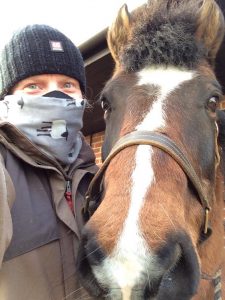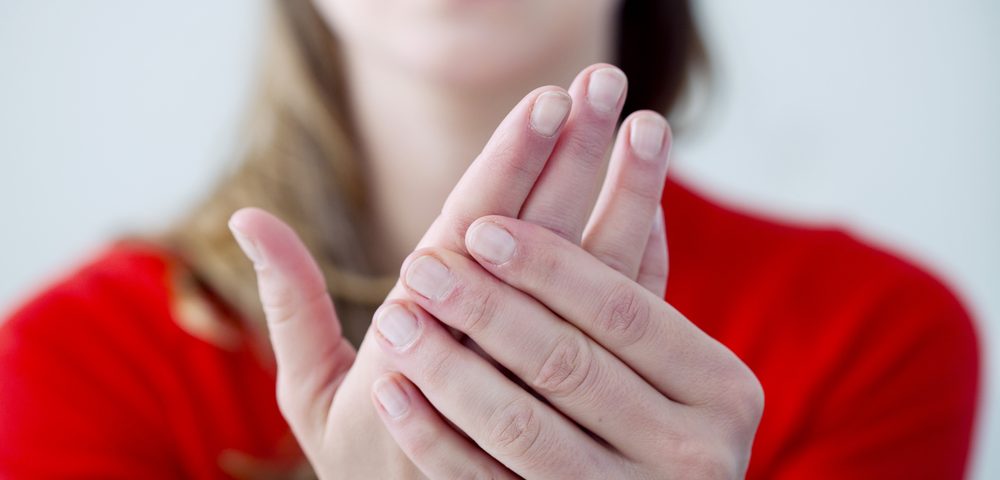A guest column by Jane Ogilvie
Having been diagnosed with primary Raynaud’s in my mid-20s, nearly 20 years ago, I have been learning since what helps me to manage my Raynaud’s and what does not. I am quite lucky, as I am not severely affected compared to some.
However, I am regularly exposed to the elements and the outdoors when looking after my pony. I was also a motorcyclist until three years ago — but a fair-weather biker, so I only ventured out when the weather was fit (not all that often in the UK!). I still have my pony, and so, I am out in all types of weather at least twice daily.

Over the years I have tried ginger and gingko biloba supplements — neither of which I felt provided any benefit. I have tried a few different types of clothing, and thermal base layers work well with many layers over the top, finished off with a waterproof and windproof outer layer if possible. It means feeling like the Michelin man, and I have often worn two coats at the same time, but it is worth it. Neck tubes and scarves are a must, both together for extra heat retention! Deerstalker-style hats really help, especially when protecting the ears against a biting wind.
Footwear in a muddy field for me has to be neoprene Wellingtons; there are several brands around and all, I assume, are similar. I have found it is important to not have socks which make footwear tight, as this can also compromise circulation. Neoprene face masks, sold for use by skiers or motorcyclists, are excellent too.
Despite all of this, I still get cold hands and good gloves are not so easy to find. Neoprene gloves are not very useful in my experience — sailing neoprene gloves are combined with other materials, I think, to make them more durable, but thermal qualities are poor. Mittens are, of course, better than gloves but can be very restricting when you are trying to open and close gates, do/undo buckles on horse collars and rugs, etc.
Gloves, mittens and handwarmers
I ended up using ski gloves and mountaineering mittens (fit for serious subzero temperatures). I have never had much joy with heated gloves, although I guess they must work for some. Heat pads are all very well, but impractical when you are constantly using your hands. I have tried the ‘teabag-like’ ones, and also the ones that have a little metal disc inside that you flex to activate.
Aside from neoprene and thermals, my other favorite material is sheepskin — and before I had an electric blanket, I used to keep sheepskin rugs on the bed. When I replace my feather duvet, I plan to try a duvet made of wool. I wear sheepskin boots to work all year round as the office is cool even in summer. I keep fleecy wristies, a bit like fingerless gloves, in my desk drawer for chilly days when typing isn’t easy.
Overall my advice would be:
YES
Waterproof and windproof outer layers
Wear thermals / Wear layers
Taking baths
Sheepskin / wool, neoprene
Gloves, hats, scarves
Bed socks
NO
Going outside in the cold if underdressed
Standing around in the cold
Putting cold hands / feet directly on a radiator
Taking showers
Wearing thin flimsy smart or dressy clothes
Driving the car before it is warmed up
Winter sports
Swimming in a pool or outdoor swimming
A few years ago, my symptoms were extremely painful during a particularly cold winter. I went to see my GP and was prescribed calcium channel blockers. Sadly, I could not tolerate the side effects of headaches and a rapid heartbeat, despite the novelty of having lovely warm hands and feet!
My strategy now is to stop getting cold — and for the most part it works well. Some things are off the cards these days, like standing outside to watch a fireworks display, going swimming or on a skiing holiday. It’s just a case of knowing my limitations, I guess.
Jane Ogilvie is a scientist who lives in Nottingham, U.K.
Note: Raynaud News is strictly a news and information website about the disease. It does not provide medical advice, diagnosis, or treatment. This content is not intended to be a substitute for professional medical advice, diagnosis, or treatment. Always seek the advice of your physician or other qualified health provider with any questions you may have regarding a medical condition. Never disregard professional medical advice or delay in seeking it because of something you have read on this website. The opinions expressed in this column are not those of Raynaud News, or its parent company, BioNews Services, and are intended to spark discussion about issues pertaining to Raynaud’s Disease.


